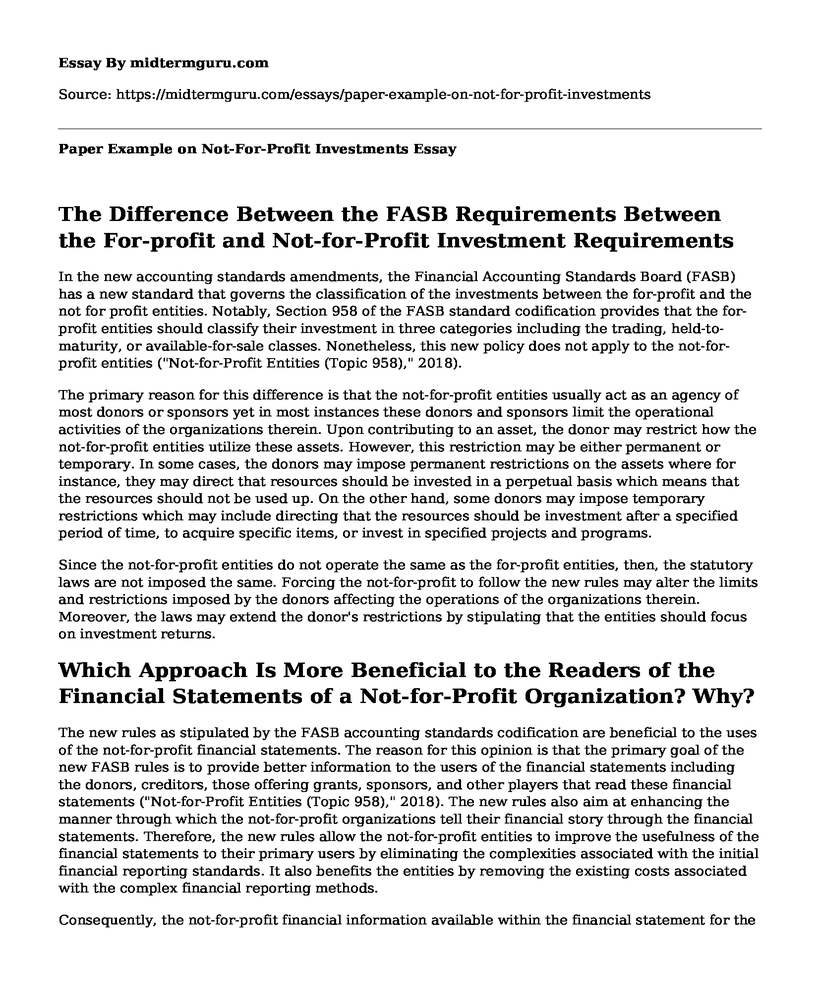The Difference Between the FASB Requirements Between the For-profit and Not-for-Profit Investment Requirements
In the new accounting standards amendments, the Financial Accounting Standards Board (FASB) has a new standard that governs the classification of the investments between the for-profit and the not for profit entities. Notably, Section 958 of the FASB standard codification provides that the for-profit entities should classify their investment in three categories including the trading, held-to-maturity, or available-for-sale classes. Nonetheless, this new policy does not apply to the not-for-profit entities ("Not-for-Profit Entities (Topic 958)," 2018).
The primary reason for this difference is that the not-for-profit entities usually act as an agency of most donors or sponsors yet in most instances these donors and sponsors limit the operational activities of the organizations therein. Upon contributing to an asset, the donor may restrict how the not-for-profit entities utilize these assets. However, this restriction may be either permanent or temporary. In some cases, the donors may impose permanent restrictions on the assets where for instance, they may direct that resources should be invested in a perpetual basis which means that the resources should not be used up. On the other hand, some donors may impose temporary restrictions which may include directing that the resources should be investment after a specified period of time, to acquire specific items, or invest in specified projects and programs.
Since the not-for-profit entities do not operate the same as the for-profit entities, then, the statutory laws are not imposed the same. Forcing the not-for-profit to follow the new rules may alter the limits and restrictions imposed by the donors affecting the operations of the organizations therein. Moreover, the laws may extend the donor's restrictions by stipulating that the entities should focus on investment returns.
Which Approach Is More Beneficial to the Readers of the Financial Statements of a Not-for-Profit Organization? Why?
The new rules as stipulated by the FASB accounting standards codification are beneficial to the uses of the not-for-profit financial statements. The reason for this opinion is that the primary goal of the new FASB rules is to provide better information to the users of the financial statements including the donors, creditors, those offering grants, sponsors, and other players that read these financial statements ("Not-for-Profit Entities (Topic 958)," 2018). The new rules also aim at enhancing the manner through which the not-for-profit organizations tell their financial story through the financial statements. Therefore, the new rules allow the not-for-profit entities to improve the usefulness of the financial statements to their primary users by eliminating the complexities associated with the initial financial reporting standards. It also benefits the entities by removing the existing costs associated with the complex financial reporting methods.
Consequently, the not-for-profit financial information available within the financial statement for the various users is majorly concerned with obtaining the fair value of the investments. The fair value does not encompass the trading status of the investments and hence does not require the classifications mentioned earlier as stipulated for the for-profit entities. Moreover, in the new rules, the not-for-profit entities are capable of providing clear and simple financial reports for the donors, government, grantmakers, and other users in making the funding decisions ("Not-for-Profit Entities (Topic 958)," 2018).
References
Not-for-Profit Entities (Topic 958). (2018). Retrieved from https://www.fasb.org/resources/ccurl/90/645/ASU%202013-06.pdf
Cite this page
Paper Example on Not-For-Profit Investments. (2022, Oct 13). Retrieved from https://midtermguru.com/essays/paper-example-on-not-for-profit-investments
If you are the original author of this essay and no longer wish to have it published on the midtermguru.com website, please click below to request its removal:
- Global Business Expansion Paper Example
- Essay on the Implications of Capital Markets
- Research Paper on Ratio and Financial Statement Analysis
- Financial Statement Analysis of Amazon
- Blockchain & Bitcoin: Revolutionizing Global Commerce & Finance - Essay Sample
- Tax Compliance & ACA: Essential Knowledge for Business Owners - Essay Sample
- Stock Market Crash: Catalyst of the Great Depression - Essay Sample







